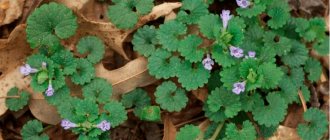Surely, when paying attention to this flower in flower arrangements, you compared it with ordinary homemade cabbage, which can be seen in the garden bed. And you are absolutely right. Brassica belongs to the ornamental types of cabbage; in itself it is a rather exotic plant, but has already earned considerable love among florists.
photo: www.instagram.com
Therefore, when choosing flower delivery on the UFL website, pay attention to the section of flower arrangements with this particular type of plant.
Piglon
Spreading variety with a compact rosette. Resembles a rose bush with smooth leaves. The lower tier of leaf blades is colored green along the edges, characteristic of ordinary white cabbage. Closer to the core of the inflorescence, the greenish tone smoothly turns into milky white and cream shades. Each leaf has a regular round shape, and closer to the center it tapers at the tips, giving the cabbage an appearance similar to the queen of flowers.
How it grows: in a flowerbed or in a pot
Cauliflower is used to decorate perennial flower beds, the so-called mixborders . By autumn, many plants in such flower beds have already finished flowering. Perennial grasses (barley, miscanthus, gray fescue), asters, chrysanthemums and annuals that are not afraid of cold weather (cineraria, ageratum, marigolds, amaranth, celosia) remain decorative. At this time, ornamental cabbage only reveals its full potential of rich color and luxurious texture of foliage.
Where and with what plants does the “vegetable rose” look good?:
The texture of ornamental cabbage leaves is combined with ceramics and wood . Flower beds lined with treated boards or small-diameter logs are attractive in the garden.
Attention! Cabbage tolerates repeated replanting if the root ball does not crumble too much when digging.
Landscape designers recommend planting varieties that are distinguished by their special beauty, unusual shape or size of the head of cabbage in separate containers - pots, cache-pots, baskets. In addition, beautifully flowering annuals, ground cover and creeping perennial plants - sedums, ivy, euonymus - can be planted in flower pots. When composing a complex composition, it is important to ensure that the plants are combined with each other, one crop emphasizes the decorative qualities of the other.
The maximum capacity of such containers is 5-10 liters. Brassica planted in a container can be conveniently transferred to another place.
Sunrise F1
Another decorative variety of cabbage, the rosette of which resembles the shape of a blossoming flower. It has a rich range of colors, combining pink, green, bright orange and light shades.
The plant is tall and therefore needs support. The long stem, decorated with small leaves, ends in a large white-yellow bud with a multi-colored core.
In addition to its spectacular appearance, this variety is famous for its unpretentiousness to growing conditions and requires watering only a couple of times a week. It is also popular among gardeners due to its frost resistance and ability to bloom until the first days of December.
Planting in open ground
The best time to plant seedlings in open ground is late summer (starting in July) or autumn. Ornamental cabbage is planted in open ground when the plants reach 10-15 cm in height.
The substrate should be well loosened and fertile, but no fertilizers should be added to it immediately before planting. It is useful to plant cabbage after rain, in cloudy weather - otherwise, you should take care of good watering of young seedlings in flower beds.
Although the leaves only color beautifully in full sun, it is a good idea to lightly shade the young plants for a few days after planting to prevent them from wilting.
The suitable spacing for planting cabbage in the ground is 40-50 cm or 50-60 cm, depending on the variety. If we want to get a colorful carpet rather than individual heads, we can plant the seedlings more densely. When planting, you can maintain the same depth at which the seedlings grew in pots or plant a little deeper. When planting flush with the ground, newly planted cabbage should be hilled, which promotes better rooting of young plants.
Lace frill
One of the most attractive varieties of ornamental cabbage delights gardeners with its beauty until the first snow falls. It grows up to half a meter and has openwork leaves that resemble a lace collar.
The rosette is painted in all shades of pink and purple. The lower tier of leaf blades has a rich green color. The tone of the frills along the edges of the leaves varies from greenish to purple or deep pink.
Recent Entries
Lilac perennials that are beautiful, compact and do not crowd out other plants Why when buying seedlings you should not take the sellers’ word for it and how to determine the age of the plant using 3 signs Tomato seedlings have turned purple or whitish: why the color has changed and how to save the plants
How to extend the life of ornamental cabbage
In autumn, with the onset of cold weather, the most beautiful bushes can be dug up and planted in a flowerpot or bucket. There is no need to keep it in the room on the windowsill, next to the heating radiator. This culture does not like dry and warm air. It is recommended to place it on a glazed balcony, in a winter garden or on a veranda, that is, in a cool and well-lit room. If the plot is located under your windows, then leave the plants in the garden bed; you will be able to admire its beauty for a long time. And against the background of snow, decorated with frost, decorative cabbage will look simply fabulous.
Ornamental cabbage continues to reign in the garden even after the first frosts and snowfalls
Cabbage is a biennial crop. If you save it until spring and plant it again in the garden, it will produce an arrow decorated with beautiful flowers. You can admire it again and collect seeds. To plant in the second year, cabbage must be dug up by the roots before the first frost; frozen cabbage will rot in winter. The soil is shaken off the root and hung in the cellar with the rosette facing down. The leaves will not wither if optimal conditions for cabbage are created in the storage: temperature +1... -1 ⁰C, humidity - 85–95%. Walls, floors and shelves must be disinfected with lime, Anti-Rot preparation, etc.
Video: second life of ornamental cabbage
Tokyo
A hybrid variety resembling the shape of a blossoming peony. It has a dense and multi-layered rosette consisting of rounded leaf plates. It grows no higher than 35 cm, but is quite spreading.
The color palette of the openwork leaves of the rosette consists of rich shades: pink, burgundy-red, milky white. The lower leaves are gray-green with subtle hints of purple.
Growing ornamental cabbage
Cabbage seeds germinate in 3–5 days. From the first moments, small sprouts need plenty of sunlight and coolness. Conditions in closed and open ground are different. Therefore, care will be different.
With a lack of light, cabbage seedlings do not acquire a rich green color, become elongated, and grow weak
How to care for seedlings
As soon as the first loops of seedlings appear from the ground, move the box with seedlings to the brightest and coolest place. This could be a glazed balcony or veranda. Perhaps it has become warmer outside, and there is an opportunity to put the seedlings in a greenhouse or hothouse. For the first 3–4 days, the temperature should be at +8… +10 ⁰C, and in subsequent days no higher than +18 ⁰C. When growing on a windowsill, illuminate with a phytolamp, especially on cloudy days. In warm weather and with a lack of light, the stems will stretch out and fall to the ground; contact with it can cause blackleg.
Spoonbill
A decorative variety of cabbage often used to decorate flower beds, flowerpots, and ridges. The rosette is shaped like a rosebud that has opened its petals. The color is soft pink with subtle hints of purple. The height of the plant does not exceed 50 cm, but the plant stands out among others due to the splendor of the inflorescence.
It is unpretentious and frost-resistant. It calmly tolerates the first frosts, temperatures down to -10 degrees Celsius and survives until the end of the autumn season, when many other cabbage varieties are already withering. Closer to summer, the color of the platinum sheets becomes more saturated.
Types of ornamental cabbage
Ornamental cabbage is the queen of the autumn garden. It will attract and delight the eye in September - October, when almost all crops have finished their growing season. The plant tolerates temperatures down to -8 ⁰C. And the variety of types and varieties gives you room for imagination. You can create flower beds, geometric shapes, pyramids, or randomly place large single bushes throughout the garden. There are compact forms that can grow in flower pots.
Compact ornamental cabbage grows well in pots
On sale you can find cabbages that look like huge roses or peonies, with carved or curly leaves. One rosette can be painted in 2-3 colors. Moreover, the color range is not limited in any way. There are ornamental cabbages with red, pink, burgundy, white, purple, blue, yellow and, of course, green leaves. Rosettes of leaves look elegant, on which bright strokes are applied as if by chance against a light background.
Ornamental cabbage is not inferior in beauty to roses and tulips
Before you go to the store for seeds, decide for yourself what kind of ornamental cabbage you need:
- growing as a tall bush (from 50 cm) with a flower at the top;
- short, with a squat rosette;
- large or compact;
- with openwork, wavy or solid and even leaves;
- yellow, red, blue shades or two or three colors.
For those who cannot decide, they sell variety mixtures of ornamental cabbage.
Video: what types of ornamental cabbage are, cultural features
Robin
One of the largest and tallest mid-season varieties with petioles up to 100-150 cm and a rosette diameter of about half a meter. The leaves are elongated, corrugated, lacy at the edges, slightly drooping. Coloration varies from dark purple to muted burgundy. It is popular among gardeners not only for its spectacular appearance, but also for its pleasant taste.
- Author: iarriba
Rate this article:
- 5
- 4
- 3
- 2
- 1
(0 votes, average: 0 out of 5)
Share with your friends!
Reproduction
You can plant ornamental cabbage from seedlings or seeds purchased at the store. Or you can collect the seeds yourself. This is not a labor-intensive process, but it is quite lengthy. The seeds are collected in the second year of plant growth, when the decorative properties have decreased.
To have a lot of seeds, plant cabbage after winter at a small distance from each other so that it is better pollinated.
How to collect seeds
Cabbage begins to throw out arrows no earlier than June. But this does not mean that you can already collect seeds. The seeds are collected in November. And so that during this time the birds do not eat everything, wrap the arrows with cloth. Most often, gardeners use nylon or cotton. Cut off the bolls when they are well dry. Then thresh it.
Arrows with seeds.
Caprice
The variety is represented by rather low specimens, up to 50 cm in height. The bright crimson center is framed by dark green foliage. The edge is smooth, there is a waxy coating.
This species is even eaten. It is only necessary to first freeze the product before use to remove the bitterness. Unusual flowers are very beautiful and productive.
Nagoya white
The Japanese hybrid is a low plant with a rounded head that looks like a large white bud with heavily corrugated edges. The stem is short, only 25-30 cm, the outer leaves are light green, the inner leaves are pure white.
With the onset of frost, the color of the rosette becomes even fresher and brighter.
Nagoya is frost-resistant, very hardy to adverse weather conditions, and unpretentious. Lush terry foliage looks like skillfully knitted lace.
Where to buy quality seeds
It is safest to plant brassica seedlings. This increases the likelihood of getting a beautiful harvest. But if you want to plant cabbage seeds, you must first buy them somewhere.
It is safest to buy seeds in your city, especially if we are talking about a small town. But there is little choice locally. These are usually the most popular varieties. But sometimes you want something original. In this case, the Internet will come to the rescue.
Choose sites with a large number of reviews that have been operating for several years. Most likely, their delivery is well organized and you will receive a quality product.
Popular varieties
"Kai and Gerda" Belongs to group 1, the stems are rough and have a height of 60 cm, the leaves are pale in color.
The lark's tongue." The leaves are in most cases dark in color, with carved edges.
"Red High" It differs from other varieties in its large diameter, up to 70 cm. The leaves are located along the entire length of the stem and have a purple tint.
Red Bor - has a stem height of about 80 cm. The leaves are bright red.
"Robin". The diameter can be up to 40 cm, height up to one and a half meters. Color from red to violet. Copes well with low temperatures.
"Colors of the East". One of the latest options. The rosette is grayish-green, turning into a purple hue. It easily tolerates light frosts and resists pests well.
"Green branchy." The stem of this variety reaches 70 cm. The color of the leaves is purple, pink, violet, blue, etc. It has a completely different shape, round, flattened, etc.
Disease prevention and pest protection
The enemies of pink cabbage are flea beetles, slugs, and caterpillars. The former can be washed off from a spray bottle and the damaged ornamental plants can be powdered immediately afterwards with ash, tobacco or red pepper.
Sprinkling the ground with pine needles or eggshells helps against slugs. The proximity of cabbage to marigolds is both decorative and useful, because Butterflies cannot stand them. Caterpillars and snails have to be collected manually or the plants must be sprayed with Aktara (1 g per bucket), Groza or Meta.
Prevention of the fungal disease “black leg”, from which seedlings suffer, is to water cabbage plantings in moderation (spraying is better). As a last resort, you have to resort to spraying with Actillic.
Reviews from gardeners
Maria, 48 years old
This is not such an unpretentious plant. She is often affected by all sorts of diseases, caterpillars and slugs eat for her sweet soul, so she needs to worry about it. But I still periodically plant ornamental cabbage at the dacha. How beautiful it looks when everything is gray and dirty. For this I forgive her all her shortcomings.
Nastya, 32 years old
I saw enough of the bouquets with decorative cabbage and decided to plant some for myself so that I could create bouquets for the children for school. The flowerbed is small. Therefore, I did not take into account a very important point. Cabbage strangled absolutely all other flowers. But she herself grew up as if for show.
Slava, 37 years old
I'm not much of a gardener, so the first pancake came out lumpy. I bought brassica in the spring, planted it in a flowerbed... And after a while it became ugly and sprouted. It turned out that I bought last year’s, which is planted for seeds, and not for beauty. But I found out it was too late. I collected these seeds and will try to sow them next year. Why should good things go to waste?
Vera, 43 years old
I really like to plant ornamental cabbage. Looks great in the fall. I also have regular cabbage growing on my plot. I take care the same way. The only negative for me is the slugs and the smell. In autumn, the flowerbed smells strongly of cabbage. But it’s not under my windows, so there’s no problem.











